Effective Leadership Styles within the British Army: A Review
VerifiedAdded on 2022/09/16
|19
|5071
|14
Report
AI Summary
This report provides a comprehensive literature review on leadership styles within the British Army, focusing on transactional, transformational, and empowerment leadership approaches. The study explores the conceptual understanding of leadership, analyzing the impact of various leadership styles on the British Army's performance. It evaluates the advantages and limitations of each style, drawing on academic research and theoretical perspectives. The report examines the need for leadership in the British military, discussing challenges and obstacles faced by leaders. It also suggests leadership strategies for improving the British Army's effectiveness. The report covers the planned methodology, including the research philosophy, approach, strategy, choice, methods, time horizon, and procedures used to gather data. The conclusion summarizes the key findings and recommendations for effective leadership within the British Army.
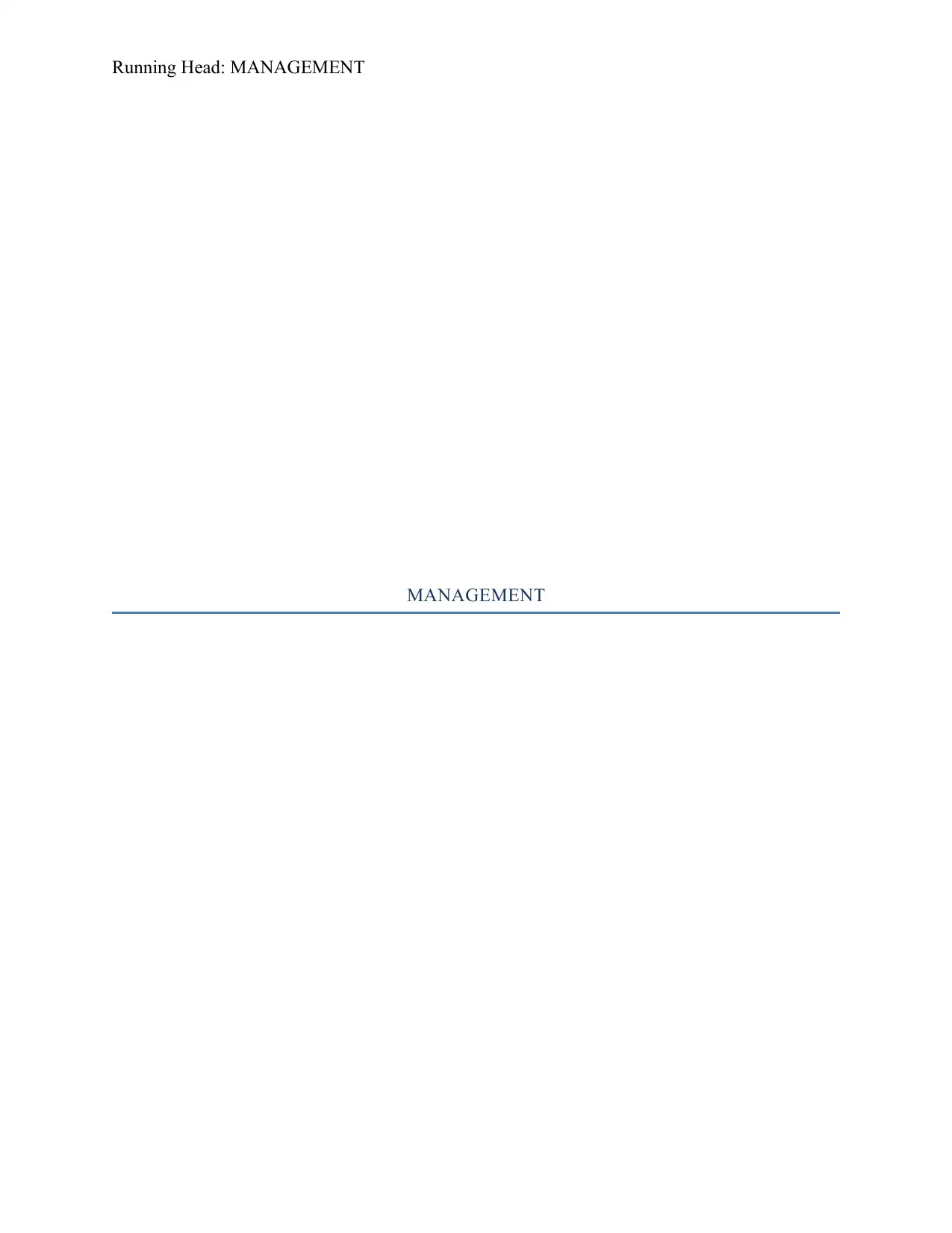
Running Head: MANAGEMENT
MANAGEMENT
MANAGEMENT
Paraphrase This Document
Need a fresh take? Get an instant paraphrase of this document with our AI Paraphraser
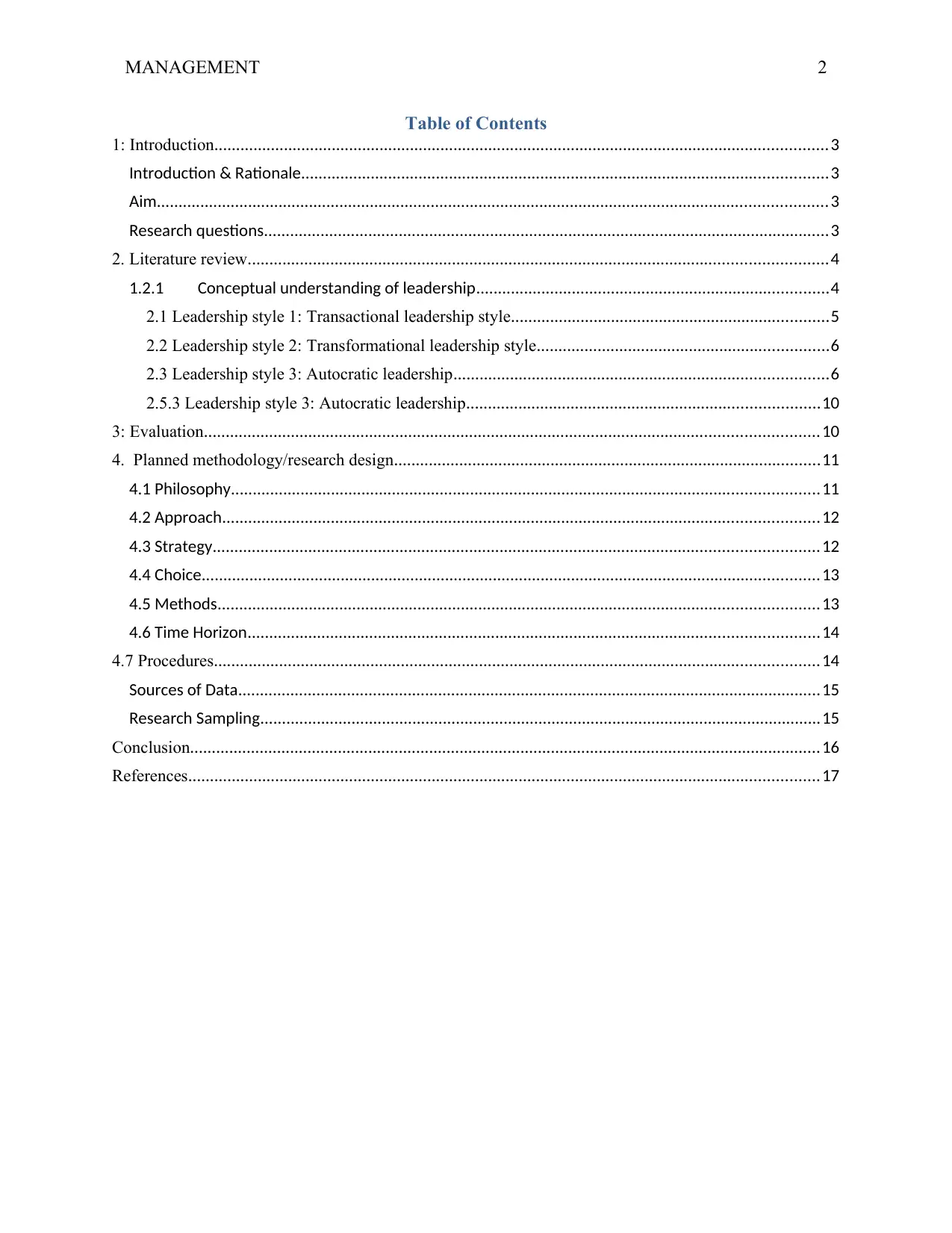
MANAGEMENT 2
Table of Contents
1: Introduction.............................................................................................................................................3
Introduction & Rationale.........................................................................................................................3
Aim..........................................................................................................................................................3
Research questions..................................................................................................................................3
2. Literature review.....................................................................................................................................4
1.2.1 Conceptual understanding of leadership.................................................................................4
2.1 Leadership style 1: Transactional leadership style.........................................................................5
2.2 Leadership style 2: Transformational leadership style...................................................................6
2.3 Leadership style 3: Autocratic leadership......................................................................................6
2.5.3 Leadership style 3: Autocratic leadership.................................................................................10
3: Evaluation.............................................................................................................................................10
4. Planned methodology/research design..................................................................................................11
4.1 Philosophy.......................................................................................................................................11
4.2 Approach.........................................................................................................................................12
4.3 Strategy...........................................................................................................................................12
4.4 Choice..............................................................................................................................................13
4.5 Methods..........................................................................................................................................13
4.6 Time Horizon...................................................................................................................................14
4.7 Procedures...........................................................................................................................................14
Sources of Data......................................................................................................................................15
Research Sampling.................................................................................................................................15
Conclusion.................................................................................................................................................16
References.................................................................................................................................................17
Table of Contents
1: Introduction.............................................................................................................................................3
Introduction & Rationale.........................................................................................................................3
Aim..........................................................................................................................................................3
Research questions..................................................................................................................................3
2. Literature review.....................................................................................................................................4
1.2.1 Conceptual understanding of leadership.................................................................................4
2.1 Leadership style 1: Transactional leadership style.........................................................................5
2.2 Leadership style 2: Transformational leadership style...................................................................6
2.3 Leadership style 3: Autocratic leadership......................................................................................6
2.5.3 Leadership style 3: Autocratic leadership.................................................................................10
3: Evaluation.............................................................................................................................................10
4. Planned methodology/research design..................................................................................................11
4.1 Philosophy.......................................................................................................................................11
4.2 Approach.........................................................................................................................................12
4.3 Strategy...........................................................................................................................................12
4.4 Choice..............................................................................................................................................13
4.5 Methods..........................................................................................................................................13
4.6 Time Horizon...................................................................................................................................14
4.7 Procedures...........................................................................................................................................14
Sources of Data......................................................................................................................................15
Research Sampling.................................................................................................................................15
Conclusion.................................................................................................................................................16
References.................................................................................................................................................17
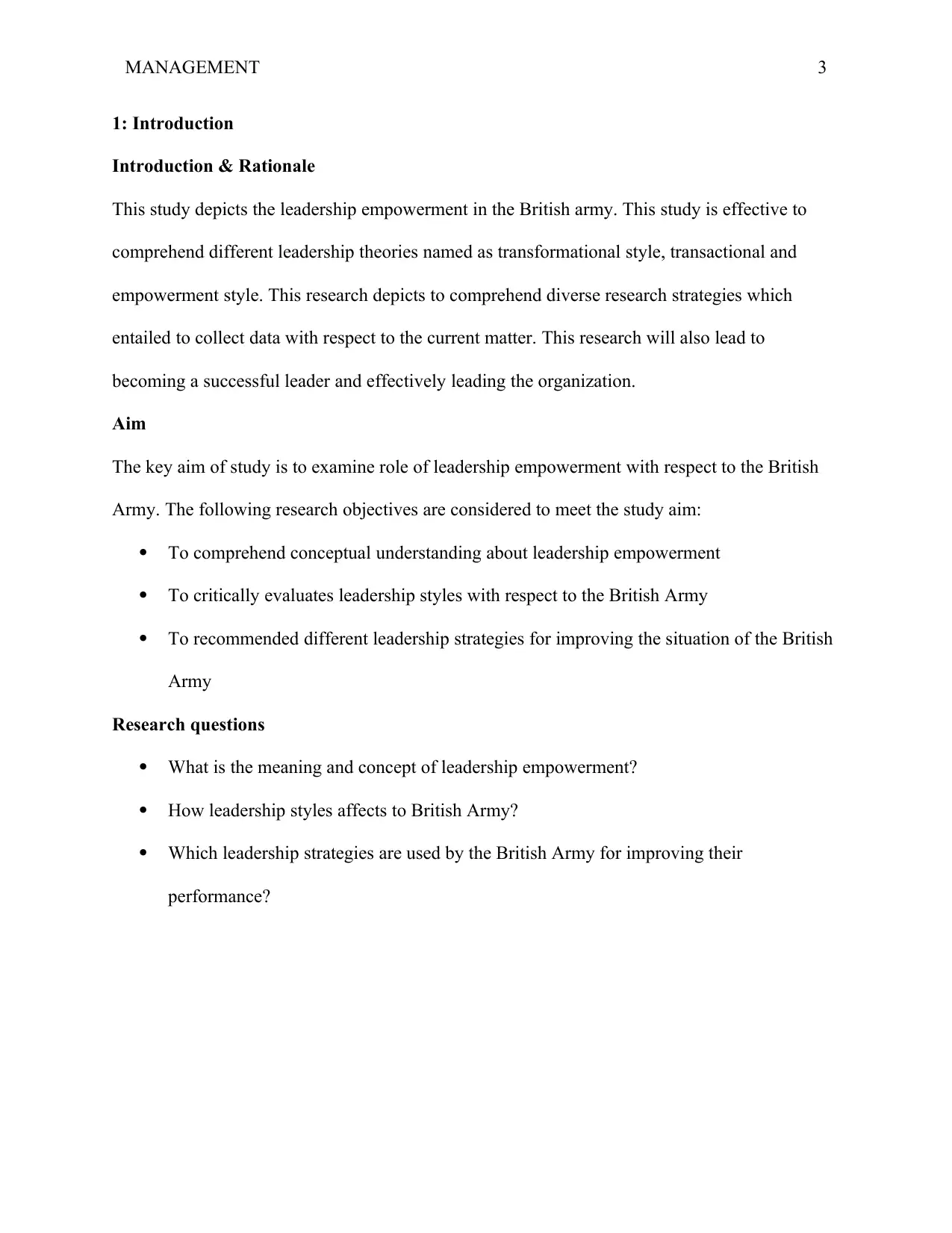
MANAGEMENT 3
1: Introduction
Introduction & Rationale
This study depicts the leadership empowerment in the British army. This study is effective to
comprehend different leadership theories named as transformational style, transactional and
empowerment style. This research depicts to comprehend diverse research strategies which
entailed to collect data with respect to the current matter. This research will also lead to
becoming a successful leader and effectively leading the organization.
Aim
The key aim of study is to examine role of leadership empowerment with respect to the British
Army. The following research objectives are considered to meet the study aim:
To comprehend conceptual understanding about leadership empowerment
To critically evaluates leadership styles with respect to the British Army
To recommended different leadership strategies for improving the situation of the British
Army
Research questions
What is the meaning and concept of leadership empowerment?
How leadership styles affects to British Army?
Which leadership strategies are used by the British Army for improving their
performance?
1: Introduction
Introduction & Rationale
This study depicts the leadership empowerment in the British army. This study is effective to
comprehend different leadership theories named as transformational style, transactional and
empowerment style. This research depicts to comprehend diverse research strategies which
entailed to collect data with respect to the current matter. This research will also lead to
becoming a successful leader and effectively leading the organization.
Aim
The key aim of study is to examine role of leadership empowerment with respect to the British
Army. The following research objectives are considered to meet the study aim:
To comprehend conceptual understanding about leadership empowerment
To critically evaluates leadership styles with respect to the British Army
To recommended different leadership strategies for improving the situation of the British
Army
Research questions
What is the meaning and concept of leadership empowerment?
How leadership styles affects to British Army?
Which leadership strategies are used by the British Army for improving their
performance?
⊘ This is a preview!⊘
Do you want full access?
Subscribe today to unlock all pages.

Trusted by 1+ million students worldwide
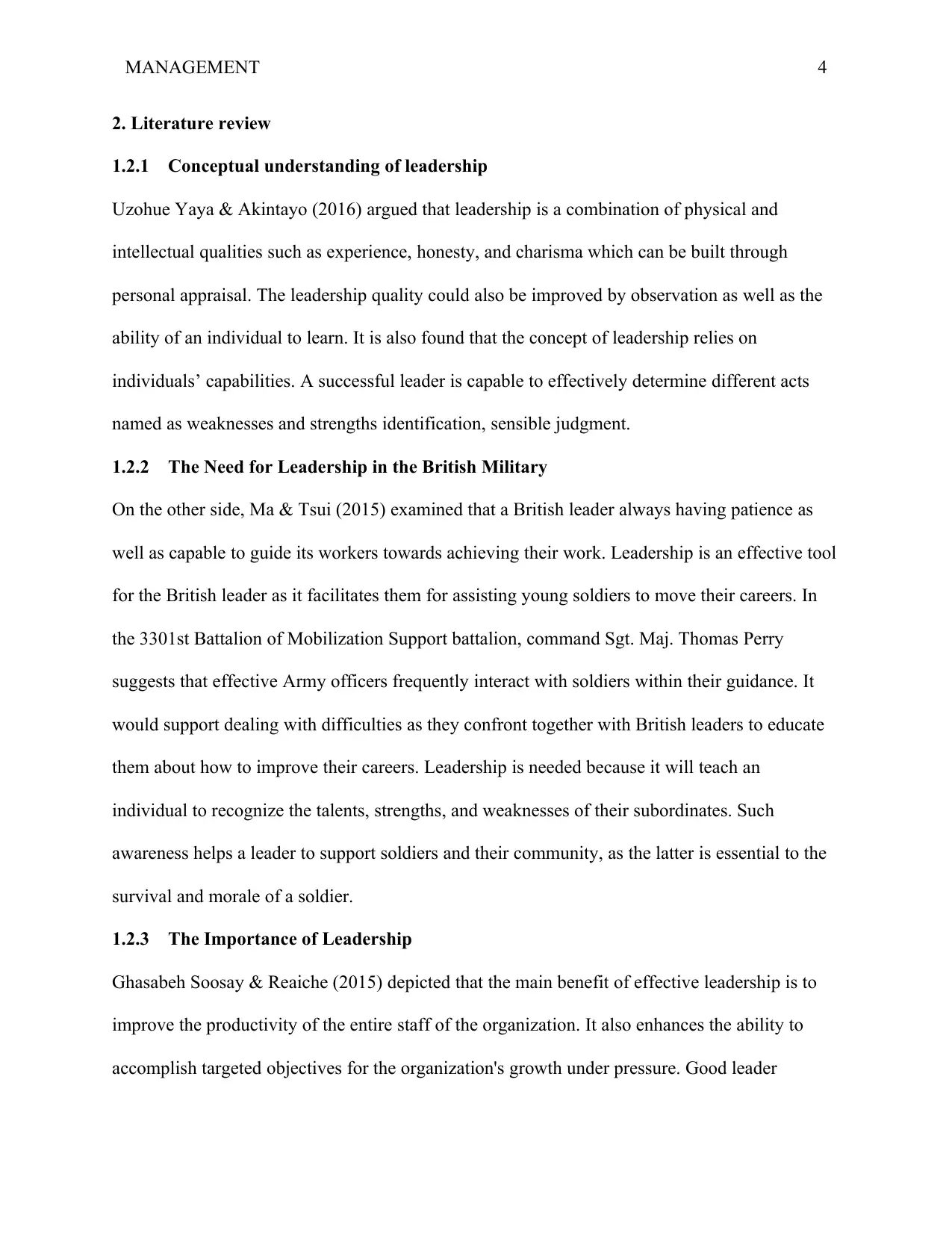
MANAGEMENT 4
2. Literature review
1.2.1 Conceptual understanding of leadership
Uzohue Yaya & Akintayo (2016) argued that leadership is a combination of physical and
intellectual qualities such as experience, honesty, and charisma which can be built through
personal appraisal. The leadership quality could also be improved by observation as well as the
ability of an individual to learn. It is also found that the concept of leadership relies on
individuals’ capabilities. A successful leader is capable to effectively determine different acts
named as weaknesses and strengths identification, sensible judgment.
1.2.2 The Need for Leadership in the British Military
On the other side, Ma & Tsui (2015) examined that a British leader always having patience as
well as capable to guide its workers towards achieving their work. Leadership is an effective tool
for the British leader as it facilitates them for assisting young soldiers to move their careers. In
the 3301st Battalion of Mobilization Support battalion, command Sgt. Maj. Thomas Perry
suggests that effective Army officers frequently interact with soldiers within their guidance. It
would support dealing with difficulties as they confront together with British leaders to educate
them about how to improve their careers. Leadership is needed because it will teach an
individual to recognize the talents, strengths, and weaknesses of their subordinates. Such
awareness helps a leader to support soldiers and their community, as the latter is essential to the
survival and morale of a soldier.
1.2.3 The Importance of Leadership
Ghasabeh Soosay & Reaiche (2015) depicted that the main benefit of effective leadership is to
improve the productivity of the entire staff of the organization. It also enhances the ability to
accomplish targeted objectives for the organization's growth under pressure. Good leader
2. Literature review
1.2.1 Conceptual understanding of leadership
Uzohue Yaya & Akintayo (2016) argued that leadership is a combination of physical and
intellectual qualities such as experience, honesty, and charisma which can be built through
personal appraisal. The leadership quality could also be improved by observation as well as the
ability of an individual to learn. It is also found that the concept of leadership relies on
individuals’ capabilities. A successful leader is capable to effectively determine different acts
named as weaknesses and strengths identification, sensible judgment.
1.2.2 The Need for Leadership in the British Military
On the other side, Ma & Tsui (2015) examined that a British leader always having patience as
well as capable to guide its workers towards achieving their work. Leadership is an effective tool
for the British leader as it facilitates them for assisting young soldiers to move their careers. In
the 3301st Battalion of Mobilization Support battalion, command Sgt. Maj. Thomas Perry
suggests that effective Army officers frequently interact with soldiers within their guidance. It
would support dealing with difficulties as they confront together with British leaders to educate
them about how to improve their careers. Leadership is needed because it will teach an
individual to recognize the talents, strengths, and weaknesses of their subordinates. Such
awareness helps a leader to support soldiers and their community, as the latter is essential to the
survival and morale of a soldier.
1.2.3 The Importance of Leadership
Ghasabeh Soosay & Reaiche (2015) depicted that the main benefit of effective leadership is to
improve the productivity of the entire staff of the organization. It also enhances the ability to
accomplish targeted objectives for the organization's growth under pressure. Good leader
Paraphrase This Document
Need a fresh take? Get an instant paraphrase of this document with our AI Paraphraser
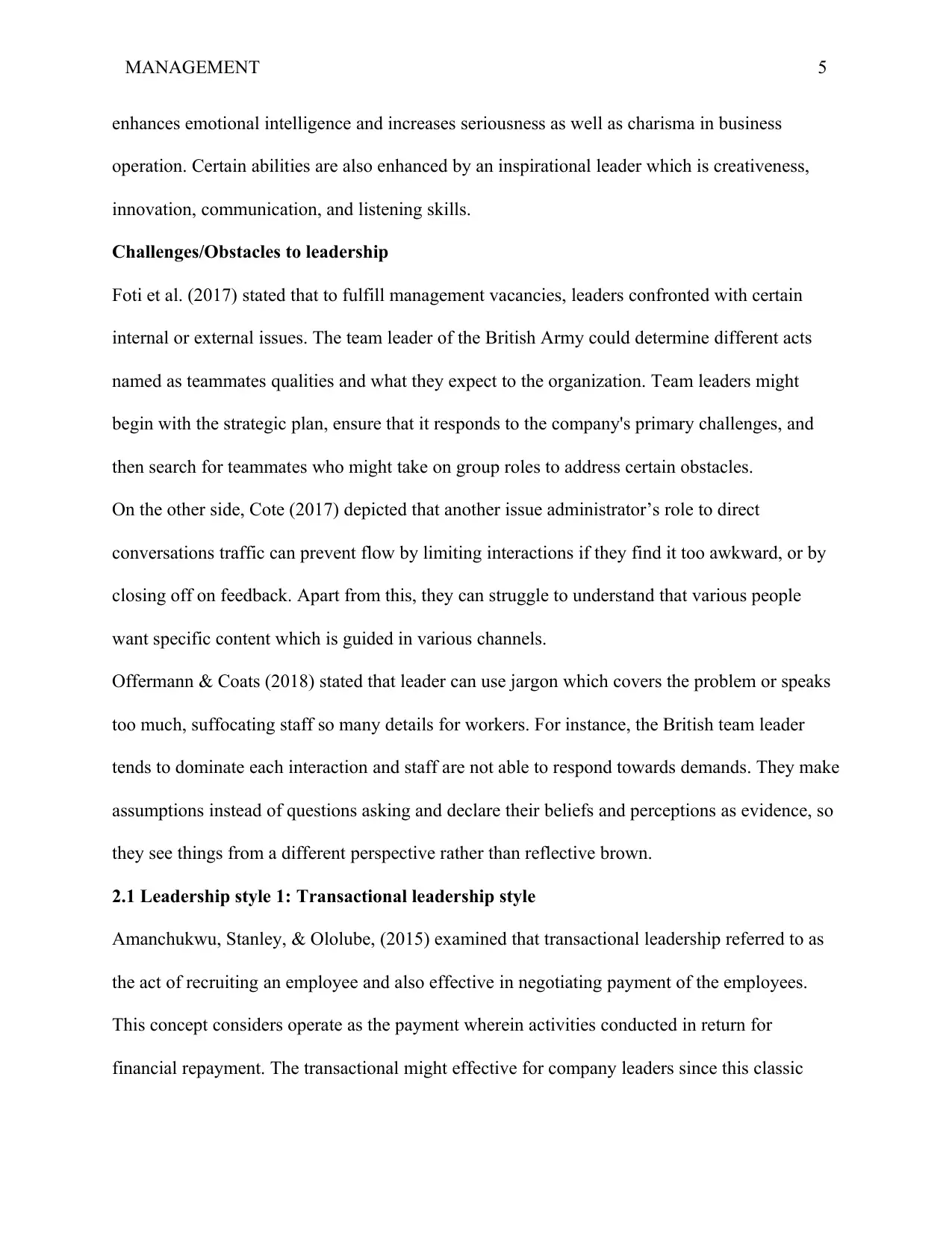
MANAGEMENT 5
enhances emotional intelligence and increases seriousness as well as charisma in business
operation. Certain abilities are also enhanced by an inspirational leader which is creativeness,
innovation, communication, and listening skills.
Challenges/Obstacles to leadership
Foti et al. (2017) stated that to fulfill management vacancies, leaders confronted with certain
internal or external issues. The team leader of the British Army could determine different acts
named as teammates qualities and what they expect to the organization. Team leaders might
begin with the strategic plan, ensure that it responds to the company's primary challenges, and
then search for teammates who might take on group roles to address certain obstacles.
On the other side, Cote (2017) depicted that another issue administrator’s role to direct
conversations traffic can prevent flow by limiting interactions if they find it too awkward, or by
closing off on feedback. Apart from this, they can struggle to understand that various people
want specific content which is guided in various channels.
Offermann & Coats (2018) stated that leader can use jargon which covers the problem or speaks
too much, suffocating staff so many details for workers. For instance, the British team leader
tends to dominate each interaction and staff are not able to respond towards demands. They make
assumptions instead of questions asking and declare their beliefs and perceptions as evidence, so
they see things from a different perspective rather than reflective brown.
2.1 Leadership style 1: Transactional leadership style
Amanchukwu, Stanley, & Ololube, (2015) examined that transactional leadership referred to as
the act of recruiting an employee and also effective in negotiating payment of the employees.
This concept considers operate as the payment wherein activities conducted in return for
financial repayment. The transactional might effective for company leaders since this classic
enhances emotional intelligence and increases seriousness as well as charisma in business
operation. Certain abilities are also enhanced by an inspirational leader which is creativeness,
innovation, communication, and listening skills.
Challenges/Obstacles to leadership
Foti et al. (2017) stated that to fulfill management vacancies, leaders confronted with certain
internal or external issues. The team leader of the British Army could determine different acts
named as teammates qualities and what they expect to the organization. Team leaders might
begin with the strategic plan, ensure that it responds to the company's primary challenges, and
then search for teammates who might take on group roles to address certain obstacles.
On the other side, Cote (2017) depicted that another issue administrator’s role to direct
conversations traffic can prevent flow by limiting interactions if they find it too awkward, or by
closing off on feedback. Apart from this, they can struggle to understand that various people
want specific content which is guided in various channels.
Offermann & Coats (2018) stated that leader can use jargon which covers the problem or speaks
too much, suffocating staff so many details for workers. For instance, the British team leader
tends to dominate each interaction and staff are not able to respond towards demands. They make
assumptions instead of questions asking and declare their beliefs and perceptions as evidence, so
they see things from a different perspective rather than reflective brown.
2.1 Leadership style 1: Transactional leadership style
Amanchukwu, Stanley, & Ololube, (2015) examined that transactional leadership referred to as
the act of recruiting an employee and also effective in negotiating payment of the employees.
This concept considers operate as the payment wherein activities conducted in return for
financial repayment. The transactional might effective for company leaders since this classic
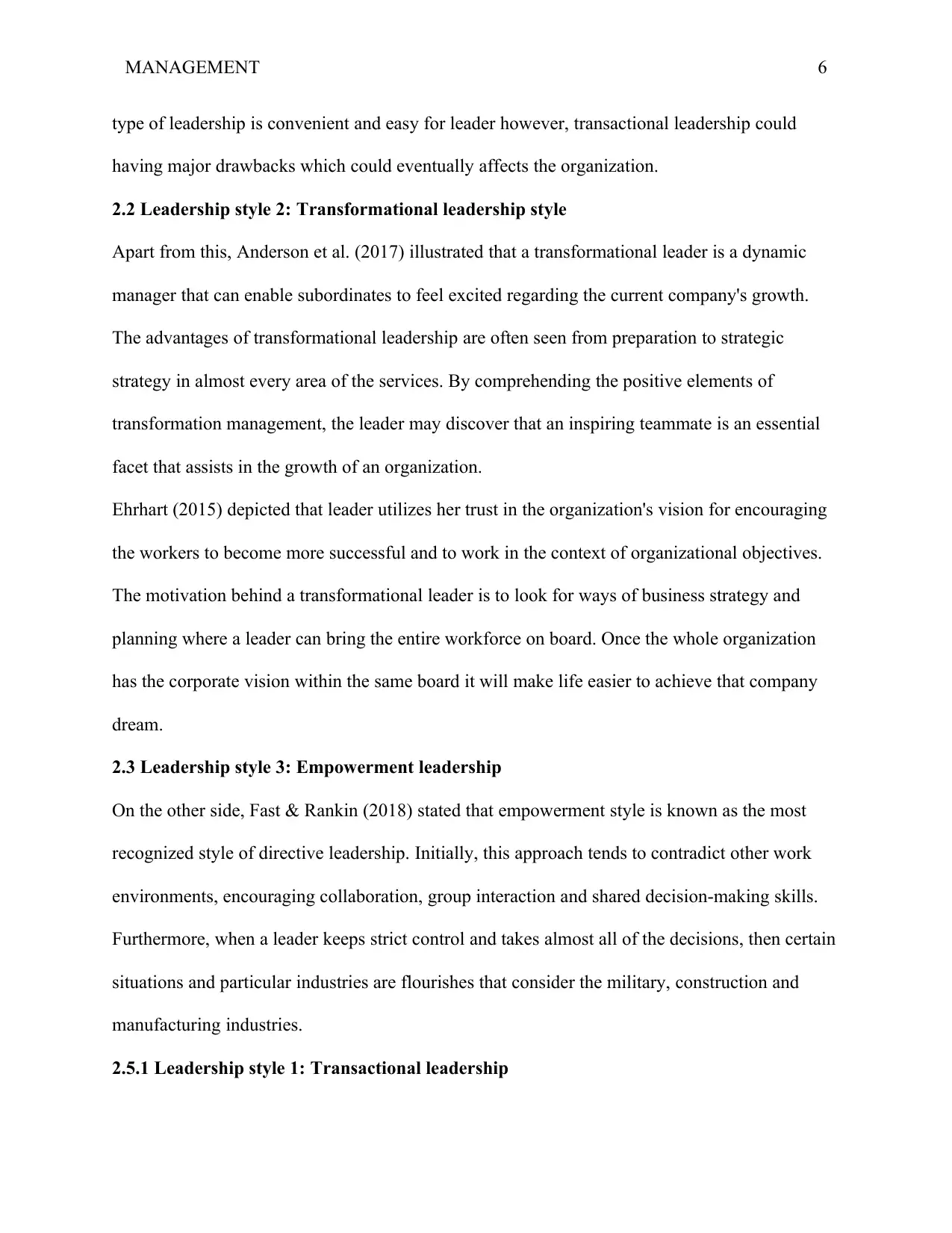
MANAGEMENT 6
type of leadership is convenient and easy for leader however, transactional leadership could
having major drawbacks which could eventually affects the organization.
2.2 Leadership style 2: Transformational leadership style
Apart from this, Anderson et al. (2017) illustrated that a transformational leader is a dynamic
manager that can enable subordinates to feel excited regarding the current company's growth.
The advantages of transformational leadership are often seen from preparation to strategic
strategy in almost every area of the services. By comprehending the positive elements of
transformation management, the leader may discover that an inspiring teammate is an essential
facet that assists in the growth of an organization.
Ehrhart (2015) depicted that leader utilizes her trust in the organization's vision for encouraging
the workers to become more successful and to work in the context of organizational objectives.
The motivation behind a transformational leader is to look for ways of business strategy and
planning where a leader can bring the entire workforce on board. Once the whole organization
has the corporate vision within the same board it will make life easier to achieve that company
dream.
2.3 Leadership style 3: Empowerment leadership
On the other side, Fast & Rankin (2018) stated that empowerment style is known as the most
recognized style of directive leadership. Initially, this approach tends to contradict other work
environments, encouraging collaboration, group interaction and shared decision-making skills.
Furthermore, when a leader keeps strict control and takes almost all of the decisions, then certain
situations and particular industries are flourishes that consider the military, construction and
manufacturing industries.
2.5.1 Leadership style 1: Transactional leadership
type of leadership is convenient and easy for leader however, transactional leadership could
having major drawbacks which could eventually affects the organization.
2.2 Leadership style 2: Transformational leadership style
Apart from this, Anderson et al. (2017) illustrated that a transformational leader is a dynamic
manager that can enable subordinates to feel excited regarding the current company's growth.
The advantages of transformational leadership are often seen from preparation to strategic
strategy in almost every area of the services. By comprehending the positive elements of
transformation management, the leader may discover that an inspiring teammate is an essential
facet that assists in the growth of an organization.
Ehrhart (2015) depicted that leader utilizes her trust in the organization's vision for encouraging
the workers to become more successful and to work in the context of organizational objectives.
The motivation behind a transformational leader is to look for ways of business strategy and
planning where a leader can bring the entire workforce on board. Once the whole organization
has the corporate vision within the same board it will make life easier to achieve that company
dream.
2.3 Leadership style 3: Empowerment leadership
On the other side, Fast & Rankin (2018) stated that empowerment style is known as the most
recognized style of directive leadership. Initially, this approach tends to contradict other work
environments, encouraging collaboration, group interaction and shared decision-making skills.
Furthermore, when a leader keeps strict control and takes almost all of the decisions, then certain
situations and particular industries are flourishes that consider the military, construction and
manufacturing industries.
2.5.1 Leadership style 1: Transactional leadership
⊘ This is a preview!⊘
Do you want full access?
Subscribe today to unlock all pages.

Trusted by 1+ million students worldwide
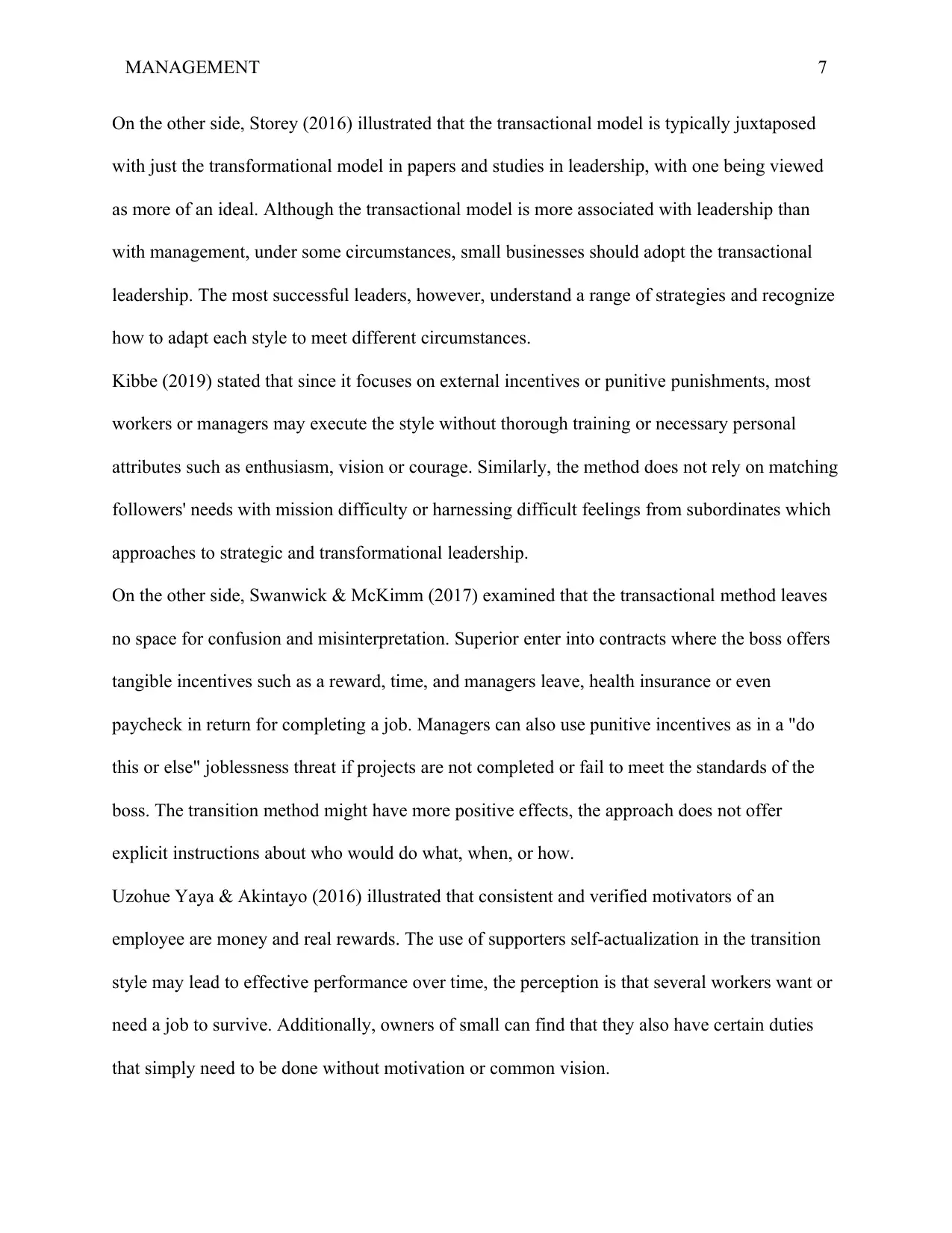
MANAGEMENT 7
On the other side, Storey (2016) illustrated that the transactional model is typically juxtaposed
with just the transformational model in papers and studies in leadership, with one being viewed
as more of an ideal. Although the transactional model is more associated with leadership than
with management, under some circumstances, small businesses should adopt the transactional
leadership. The most successful leaders, however, understand a range of strategies and recognize
how to adapt each style to meet different circumstances.
Kibbe (2019) stated that since it focuses on external incentives or punitive punishments, most
workers or managers may execute the style without thorough training or necessary personal
attributes such as enthusiasm, vision or courage. Similarly, the method does not rely on matching
followers' needs with mission difficulty or harnessing difficult feelings from subordinates which
approaches to strategic and transformational leadership.
On the other side, Swanwick & McKimm (2017) examined that the transactional method leaves
no space for confusion and misinterpretation. Superior enter into contracts where the boss offers
tangible incentives such as a reward, time, and managers leave, health insurance or even
paycheck in return for completing a job. Managers can also use punitive incentives as in a "do
this or else" joblessness threat if projects are not completed or fail to meet the standards of the
boss. The transition method might have more positive effects, the approach does not offer
explicit instructions about who would do what, when, or how.
Uzohue Yaya & Akintayo (2016) illustrated that consistent and verified motivators of an
employee are money and real rewards. The use of supporters self-actualization in the transition
style may lead to effective performance over time, the perception is that several workers want or
need a job to survive. Additionally, owners of small can find that they also have certain duties
that simply need to be done without motivation or common vision.
On the other side, Storey (2016) illustrated that the transactional model is typically juxtaposed
with just the transformational model in papers and studies in leadership, with one being viewed
as more of an ideal. Although the transactional model is more associated with leadership than
with management, under some circumstances, small businesses should adopt the transactional
leadership. The most successful leaders, however, understand a range of strategies and recognize
how to adapt each style to meet different circumstances.
Kibbe (2019) stated that since it focuses on external incentives or punitive punishments, most
workers or managers may execute the style without thorough training or necessary personal
attributes such as enthusiasm, vision or courage. Similarly, the method does not rely on matching
followers' needs with mission difficulty or harnessing difficult feelings from subordinates which
approaches to strategic and transformational leadership.
On the other side, Swanwick & McKimm (2017) examined that the transactional method leaves
no space for confusion and misinterpretation. Superior enter into contracts where the boss offers
tangible incentives such as a reward, time, and managers leave, health insurance or even
paycheck in return for completing a job. Managers can also use punitive incentives as in a "do
this or else" joblessness threat if projects are not completed or fail to meet the standards of the
boss. The transition method might have more positive effects, the approach does not offer
explicit instructions about who would do what, when, or how.
Uzohue Yaya & Akintayo (2016) illustrated that consistent and verified motivators of an
employee are money and real rewards. The use of supporters self-actualization in the transition
style may lead to effective performance over time, the perception is that several workers want or
need a job to survive. Additionally, owners of small can find that they also have certain duties
that simply need to be done without motivation or common vision.
Paraphrase This Document
Need a fresh take? Get an instant paraphrase of this document with our AI Paraphraser
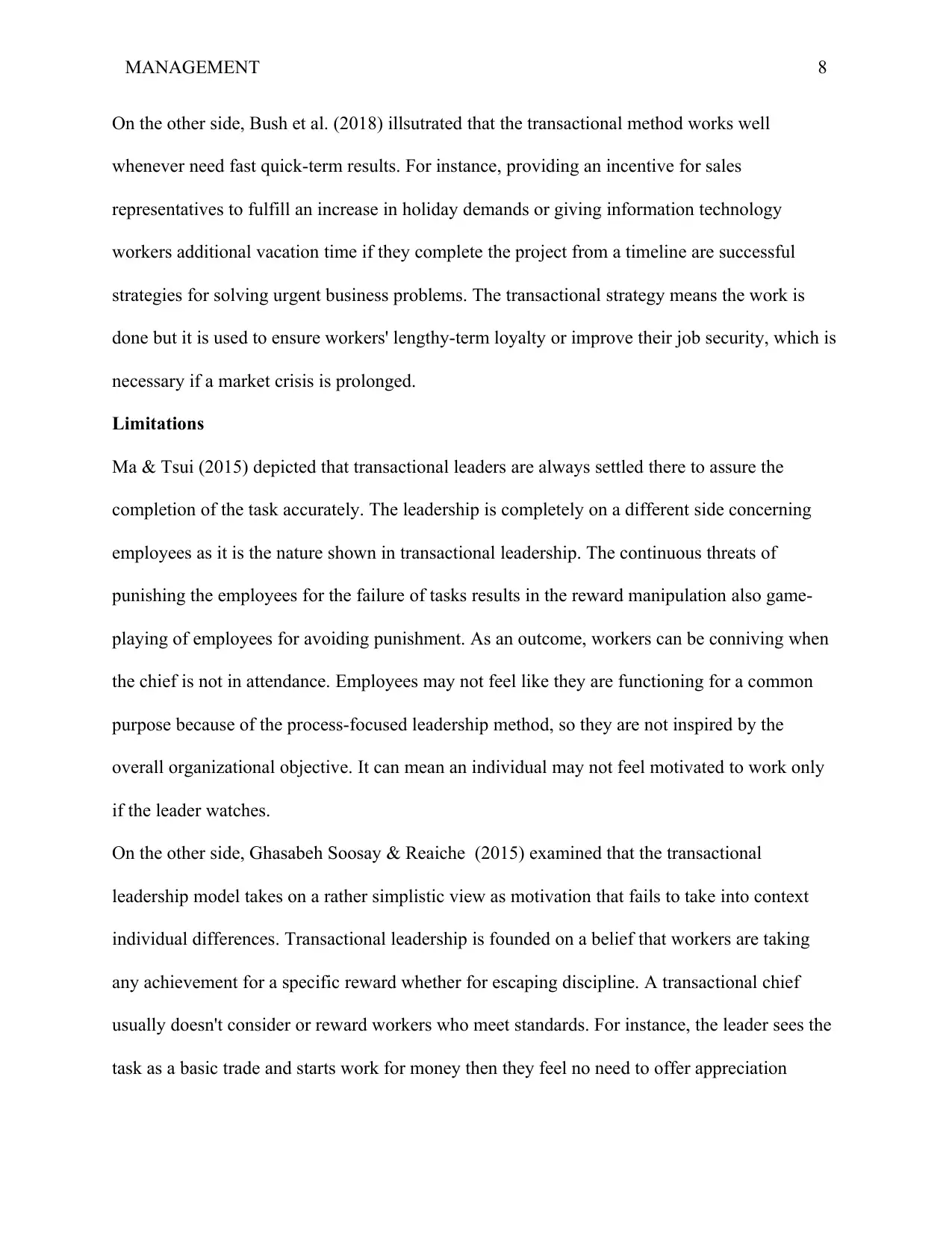
MANAGEMENT 8
On the other side, Bush et al. (2018) illsutrated that the transactional method works well
whenever need fast quick-term results. For instance, providing an incentive for sales
representatives to fulfill an increase in holiday demands or giving information technology
workers additional vacation time if they complete the project from a timeline are successful
strategies for solving urgent business problems. The transactional strategy means the work is
done but it is used to ensure workers' lengthy-term loyalty or improve their job security, which is
necessary if a market crisis is prolonged.
Limitations
Ma & Tsui (2015) depicted that transactional leaders are always settled there to assure the
completion of the task accurately. The leadership is completely on a different side concerning
employees as it is the nature shown in transactional leadership. The continuous threats of
punishing the employees for the failure of tasks results in the reward manipulation also game-
playing of employees for avoiding punishment. As an outcome, workers can be conniving when
the chief is not in attendance. Employees may not feel like they are functioning for a common
purpose because of the process-focused leadership method, so they are not inspired by the
overall organizational objective. It can mean an individual may not feel motivated to work only
if the leader watches.
On the other side, Ghasabeh Soosay & Reaiche (2015) examined that the transactional
leadership model takes on a rather simplistic view as motivation that fails to take into context
individual differences. Transactional leadership is founded on a belief that workers are taking
any achievement for a specific reward whether for escaping discipline. A transactional chief
usually doesn't consider or reward workers who meet standards. For instance, the leader sees the
task as a basic trade and starts work for money then they feel no need to offer appreciation
On the other side, Bush et al. (2018) illsutrated that the transactional method works well
whenever need fast quick-term results. For instance, providing an incentive for sales
representatives to fulfill an increase in holiday demands or giving information technology
workers additional vacation time if they complete the project from a timeline are successful
strategies for solving urgent business problems. The transactional strategy means the work is
done but it is used to ensure workers' lengthy-term loyalty or improve their job security, which is
necessary if a market crisis is prolonged.
Limitations
Ma & Tsui (2015) depicted that transactional leaders are always settled there to assure the
completion of the task accurately. The leadership is completely on a different side concerning
employees as it is the nature shown in transactional leadership. The continuous threats of
punishing the employees for the failure of tasks results in the reward manipulation also game-
playing of employees for avoiding punishment. As an outcome, workers can be conniving when
the chief is not in attendance. Employees may not feel like they are functioning for a common
purpose because of the process-focused leadership method, so they are not inspired by the
overall organizational objective. It can mean an individual may not feel motivated to work only
if the leader watches.
On the other side, Ghasabeh Soosay & Reaiche (2015) examined that the transactional
leadership model takes on a rather simplistic view as motivation that fails to take into context
individual differences. Transactional leadership is founded on a belief that workers are taking
any achievement for a specific reward whether for escaping discipline. A transactional chief
usually doesn't consider or reward workers who meet standards. For instance, the leader sees the
task as a basic trade and starts work for money then they feel no need to offer appreciation
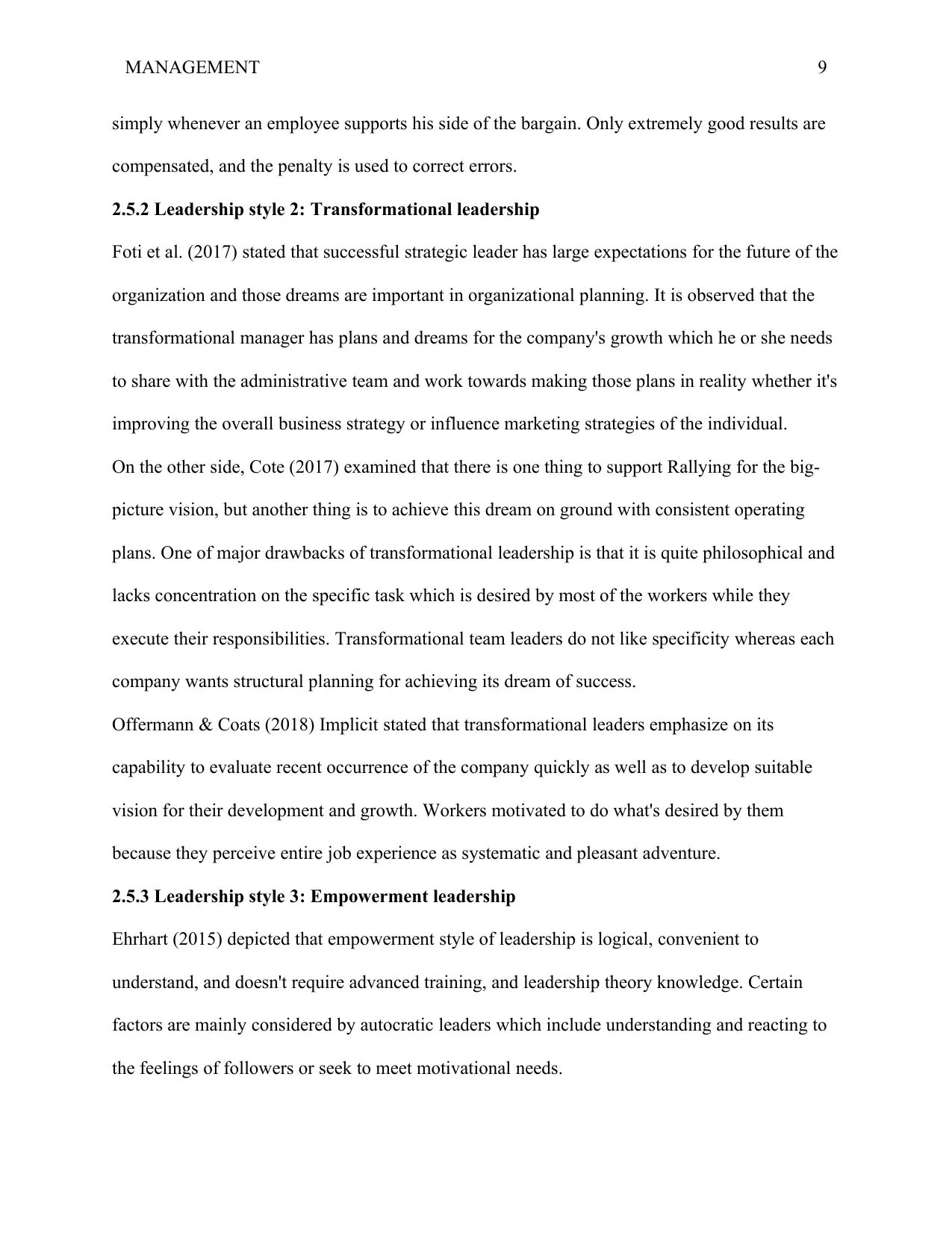
MANAGEMENT 9
simply whenever an employee supports his side of the bargain. Only extremely good results are
compensated, and the penalty is used to correct errors.
2.5.2 Leadership style 2: Transformational leadership
Foti et al. (2017) stated that successful strategic leader has large expectations for the future of the
organization and those dreams are important in organizational planning. It is observed that the
transformational manager has plans and dreams for the company's growth which he or she needs
to share with the administrative team and work towards making those plans in reality whether it's
improving the overall business strategy or influence marketing strategies of the individual.
On the other side, Cote (2017) examined that there is one thing to support Rallying for the big-
picture vision, but another thing is to achieve this dream on ground with consistent operating
plans. One of major drawbacks of transformational leadership is that it is quite philosophical and
lacks concentration on the specific task which is desired by most of the workers while they
execute their responsibilities. Transformational team leaders do not like specificity whereas each
company wants structural planning for achieving its dream of success.
Offermann & Coats (2018) Implicit stated that transformational leaders emphasize on its
capability to evaluate recent occurrence of the company quickly as well as to develop suitable
vision for their development and growth. Workers motivated to do what's desired by them
because they perceive entire job experience as systematic and pleasant adventure.
2.5.3 Leadership style 3: Empowerment leadership
Ehrhart (2015) depicted that empowerment style of leadership is logical, convenient to
understand, and doesn't require advanced training, and leadership theory knowledge. Certain
factors are mainly considered by autocratic leaders which include understanding and reacting to
the feelings of followers or seek to meet motivational needs.
simply whenever an employee supports his side of the bargain. Only extremely good results are
compensated, and the penalty is used to correct errors.
2.5.2 Leadership style 2: Transformational leadership
Foti et al. (2017) stated that successful strategic leader has large expectations for the future of the
organization and those dreams are important in organizational planning. It is observed that the
transformational manager has plans and dreams for the company's growth which he or she needs
to share with the administrative team and work towards making those plans in reality whether it's
improving the overall business strategy or influence marketing strategies of the individual.
On the other side, Cote (2017) examined that there is one thing to support Rallying for the big-
picture vision, but another thing is to achieve this dream on ground with consistent operating
plans. One of major drawbacks of transformational leadership is that it is quite philosophical and
lacks concentration on the specific task which is desired by most of the workers while they
execute their responsibilities. Transformational team leaders do not like specificity whereas each
company wants structural planning for achieving its dream of success.
Offermann & Coats (2018) Implicit stated that transformational leaders emphasize on its
capability to evaluate recent occurrence of the company quickly as well as to develop suitable
vision for their development and growth. Workers motivated to do what's desired by them
because they perceive entire job experience as systematic and pleasant adventure.
2.5.3 Leadership style 3: Empowerment leadership
Ehrhart (2015) depicted that empowerment style of leadership is logical, convenient to
understand, and doesn't require advanced training, and leadership theory knowledge. Certain
factors are mainly considered by autocratic leaders which include understanding and reacting to
the feelings of followers or seek to meet motivational needs.
⊘ This is a preview!⊘
Do you want full access?
Subscribe today to unlock all pages.

Trusted by 1+ million students worldwide
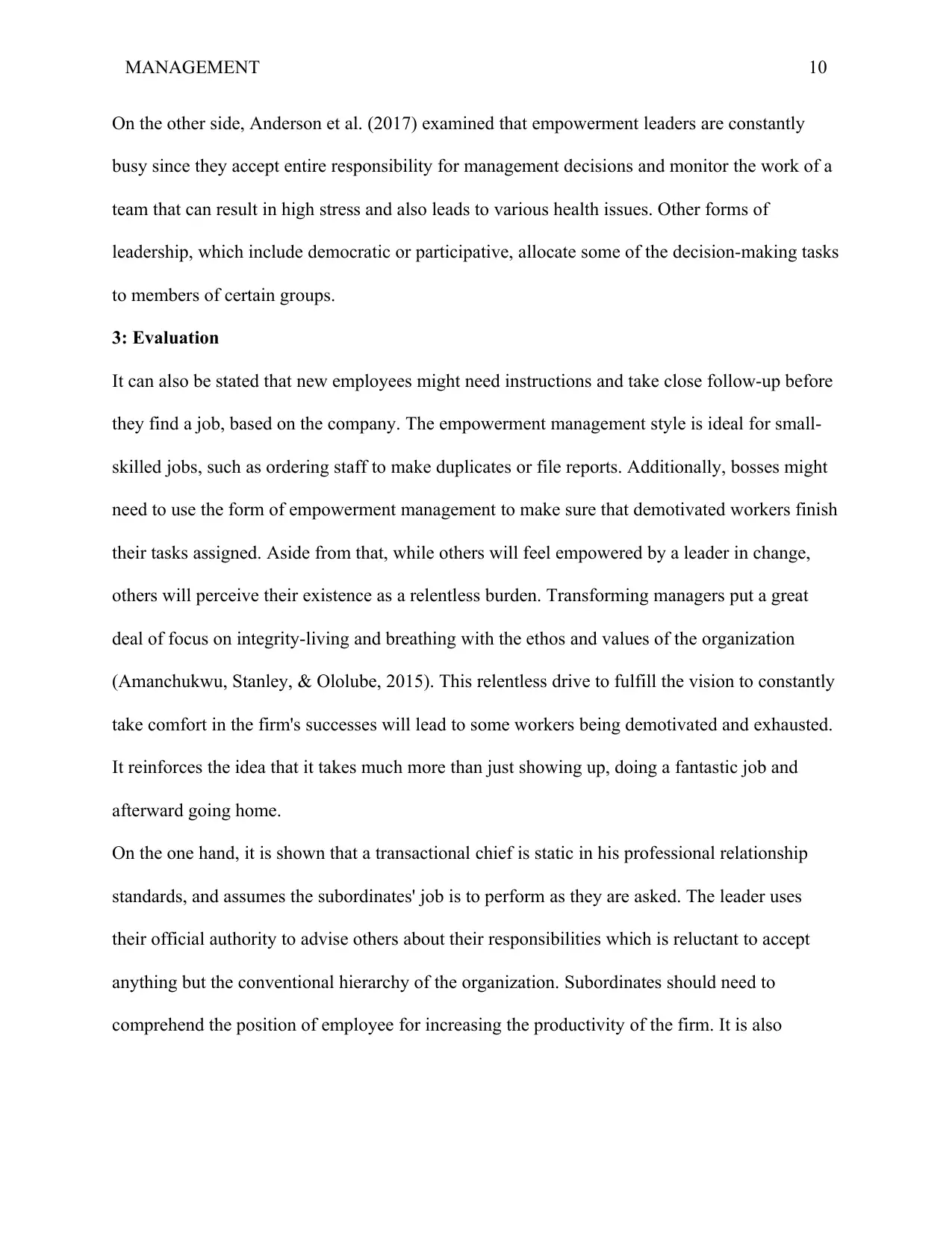
MANAGEMENT 10
On the other side, Anderson et al. (2017) examined that empowerment leaders are constantly
busy since they accept entire responsibility for management decisions and monitor the work of a
team that can result in high stress and also leads to various health issues. Other forms of
leadership, which include democratic or participative, allocate some of the decision-making tasks
to members of certain groups.
3: Evaluation
It can also be stated that new employees might need instructions and take close follow-up before
they find a job, based on the company. The empowerment management style is ideal for small-
skilled jobs, such as ordering staff to make duplicates or file reports. Additionally, bosses might
need to use the form of empowerment management to make sure that demotivated workers finish
their tasks assigned. Aside from that, while others will feel empowered by a leader in change,
others will perceive their existence as a relentless burden. Transforming managers put a great
deal of focus on integrity-living and breathing with the ethos and values of the organization
(Amanchukwu, Stanley, & Ololube, 2015). This relentless drive to fulfill the vision to constantly
take comfort in the firm's successes will lead to some workers being demotivated and exhausted.
It reinforces the idea that it takes much more than just showing up, doing a fantastic job and
afterward going home.
On the one hand, it is shown that a transactional chief is static in his professional relationship
standards, and assumes the subordinates' job is to perform as they are asked. The leader uses
their official authority to advise others about their responsibilities which is reluctant to accept
anything but the conventional hierarchy of the organization. Subordinates should need to
comprehend the position of employee for increasing the productivity of the firm. It is also
On the other side, Anderson et al. (2017) examined that empowerment leaders are constantly
busy since they accept entire responsibility for management decisions and monitor the work of a
team that can result in high stress and also leads to various health issues. Other forms of
leadership, which include democratic or participative, allocate some of the decision-making tasks
to members of certain groups.
3: Evaluation
It can also be stated that new employees might need instructions and take close follow-up before
they find a job, based on the company. The empowerment management style is ideal for small-
skilled jobs, such as ordering staff to make duplicates or file reports. Additionally, bosses might
need to use the form of empowerment management to make sure that demotivated workers finish
their tasks assigned. Aside from that, while others will feel empowered by a leader in change,
others will perceive their existence as a relentless burden. Transforming managers put a great
deal of focus on integrity-living and breathing with the ethos and values of the organization
(Amanchukwu, Stanley, & Ololube, 2015). This relentless drive to fulfill the vision to constantly
take comfort in the firm's successes will lead to some workers being demotivated and exhausted.
It reinforces the idea that it takes much more than just showing up, doing a fantastic job and
afterward going home.
On the one hand, it is shown that a transactional chief is static in his professional relationship
standards, and assumes the subordinates' job is to perform as they are asked. The leader uses
their official authority to advise others about their responsibilities which is reluctant to accept
anything but the conventional hierarchy of the organization. Subordinates should need to
comprehend the position of employee for increasing the productivity of the firm. It is also
Paraphrase This Document
Need a fresh take? Get an instant paraphrase of this document with our AI Paraphraser
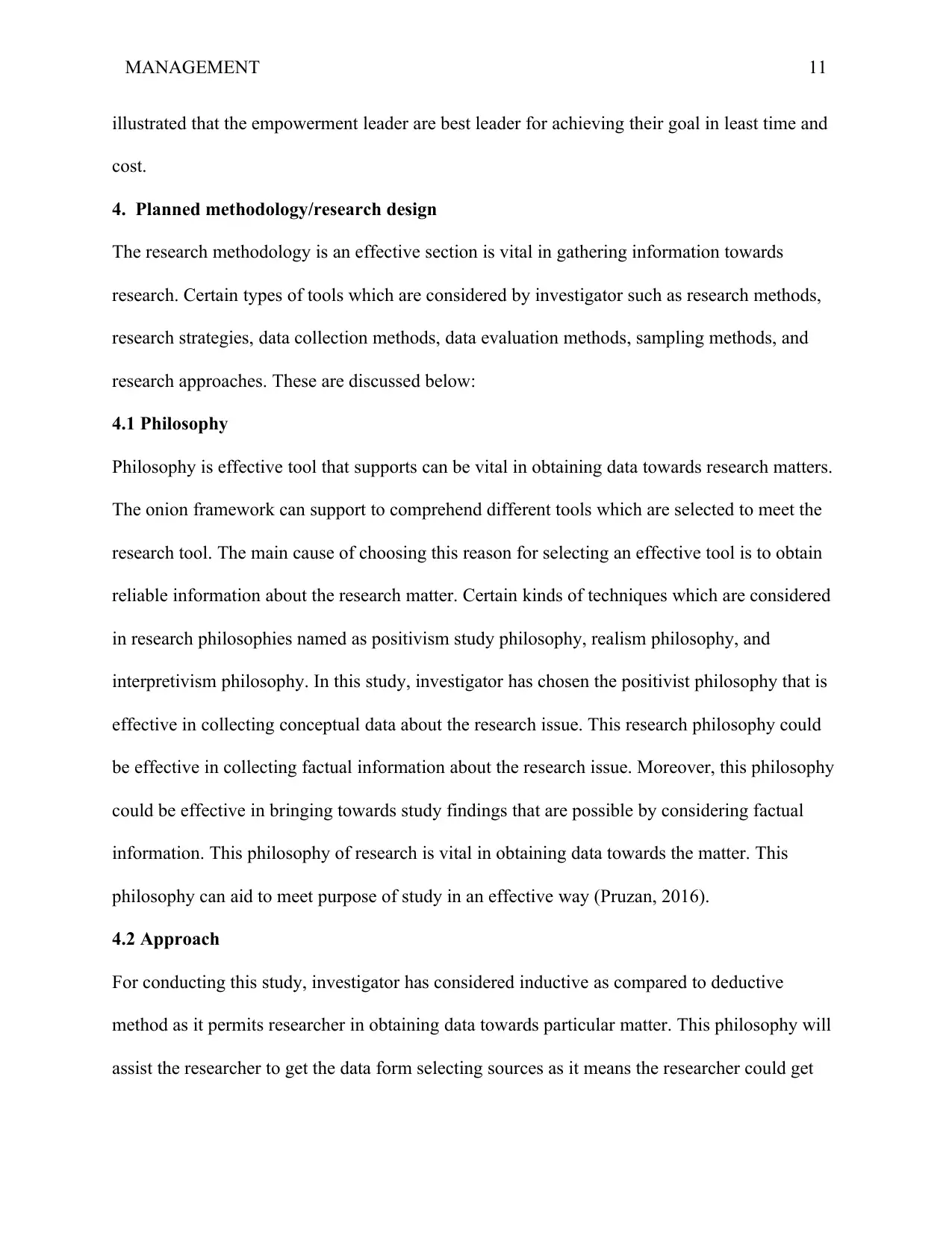
MANAGEMENT 11
illustrated that the empowerment leader are best leader for achieving their goal in least time and
cost.
4. Planned methodology/research design
The research methodology is an effective section is vital in gathering information towards
research. Certain types of tools which are considered by investigator such as research methods,
research strategies, data collection methods, data evaluation methods, sampling methods, and
research approaches. These are discussed below:
4.1 Philosophy
Philosophy is effective tool that supports can be vital in obtaining data towards research matters.
The onion framework can support to comprehend different tools which are selected to meet the
research tool. The main cause of choosing this reason for selecting an effective tool is to obtain
reliable information about the research matter. Certain kinds of techniques which are considered
in research philosophies named as positivism study philosophy, realism philosophy, and
interpretivism philosophy. In this study, investigator has chosen the positivist philosophy that is
effective in collecting conceptual data about the research issue. This research philosophy could
be effective in collecting factual information about the research issue. Moreover, this philosophy
could be effective in bringing towards study findings that are possible by considering factual
information. This philosophy of research is vital in obtaining data towards the matter. This
philosophy can aid to meet purpose of study in an effective way (Pruzan, 2016).
4.2 Approach
For conducting this study, investigator has considered inductive as compared to deductive
method as it permits researcher in obtaining data towards particular matter. This philosophy will
assist the researcher to get the data form selecting sources as it means the researcher could get
illustrated that the empowerment leader are best leader for achieving their goal in least time and
cost.
4. Planned methodology/research design
The research methodology is an effective section is vital in gathering information towards
research. Certain types of tools which are considered by investigator such as research methods,
research strategies, data collection methods, data evaluation methods, sampling methods, and
research approaches. These are discussed below:
4.1 Philosophy
Philosophy is effective tool that supports can be vital in obtaining data towards research matters.
The onion framework can support to comprehend different tools which are selected to meet the
research tool. The main cause of choosing this reason for selecting an effective tool is to obtain
reliable information about the research matter. Certain kinds of techniques which are considered
in research philosophies named as positivism study philosophy, realism philosophy, and
interpretivism philosophy. In this study, investigator has chosen the positivist philosophy that is
effective in collecting conceptual data about the research issue. This research philosophy could
be effective in collecting factual information about the research issue. Moreover, this philosophy
could be effective in bringing towards study findings that are possible by considering factual
information. This philosophy of research is vital in obtaining data towards the matter. This
philosophy can aid to meet purpose of study in an effective way (Pruzan, 2016).
4.2 Approach
For conducting this study, investigator has considered inductive as compared to deductive
method as it permits researcher in obtaining data towards particular matter. This philosophy will
assist the researcher to get the data form selecting sources as it means the researcher could get
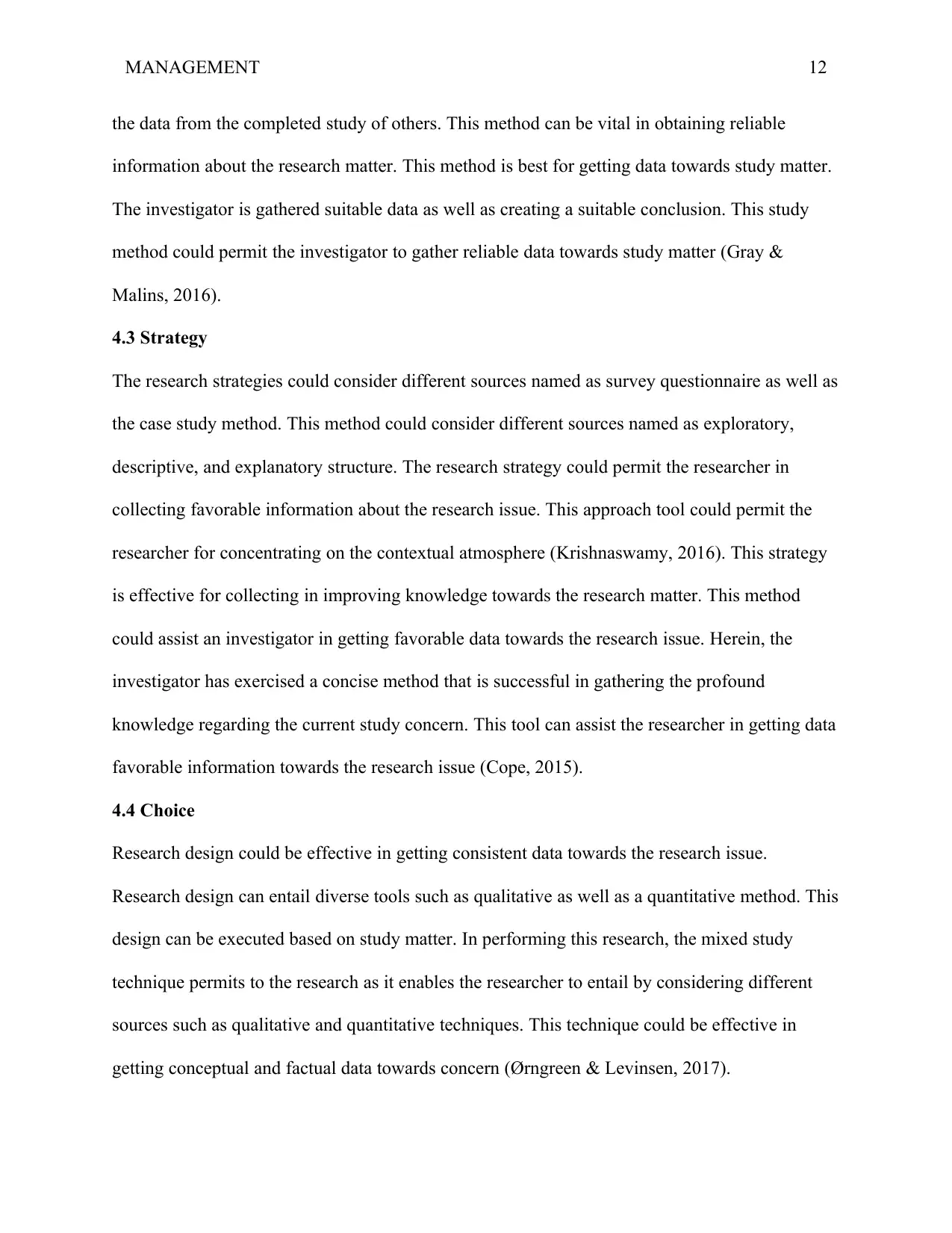
MANAGEMENT 12
the data from the completed study of others. This method can be vital in obtaining reliable
information about the research matter. This method is best for getting data towards study matter.
The investigator is gathered suitable data as well as creating a suitable conclusion. This study
method could permit the investigator to gather reliable data towards study matter (Gray &
Malins, 2016).
4.3 Strategy
The research strategies could consider different sources named as survey questionnaire as well as
the case study method. This method could consider different sources named as exploratory,
descriptive, and explanatory structure. The research strategy could permit the researcher in
collecting favorable information about the research issue. This approach tool could permit the
researcher for concentrating on the contextual atmosphere (Krishnaswamy, 2016). This strategy
is effective for collecting in improving knowledge towards the research matter. This method
could assist an investigator in getting favorable data towards the research issue. Herein, the
investigator has exercised a concise method that is successful in gathering the profound
knowledge regarding the current study concern. This tool can assist the researcher in getting data
favorable information towards the research issue (Cope, 2015).
4.4 Choice
Research design could be effective in getting consistent data towards the research issue.
Research design can entail diverse tools such as qualitative as well as a quantitative method. This
design can be executed based on study matter. In performing this research, the mixed study
technique permits to the research as it enables the researcher to entail by considering different
sources such as qualitative and quantitative techniques. This technique could be effective in
getting conceptual and factual data towards concern (Ørngreen & Levinsen, 2017).
the data from the completed study of others. This method can be vital in obtaining reliable
information about the research matter. This method is best for getting data towards study matter.
The investigator is gathered suitable data as well as creating a suitable conclusion. This study
method could permit the investigator to gather reliable data towards study matter (Gray &
Malins, 2016).
4.3 Strategy
The research strategies could consider different sources named as survey questionnaire as well as
the case study method. This method could consider different sources named as exploratory,
descriptive, and explanatory structure. The research strategy could permit the researcher in
collecting favorable information about the research issue. This approach tool could permit the
researcher for concentrating on the contextual atmosphere (Krishnaswamy, 2016). This strategy
is effective for collecting in improving knowledge towards the research matter. This method
could assist an investigator in getting favorable data towards the research issue. Herein, the
investigator has exercised a concise method that is successful in gathering the profound
knowledge regarding the current study concern. This tool can assist the researcher in getting data
favorable information towards the research issue (Cope, 2015).
4.4 Choice
Research design could be effective in getting consistent data towards the research issue.
Research design can entail diverse tools such as qualitative as well as a quantitative method. This
design can be executed based on study matter. In performing this research, the mixed study
technique permits to the research as it enables the researcher to entail by considering different
sources such as qualitative and quantitative techniques. This technique could be effective in
getting conceptual and factual data towards concern (Ørngreen & Levinsen, 2017).
⊘ This is a preview!⊘
Do you want full access?
Subscribe today to unlock all pages.

Trusted by 1+ million students worldwide
1 out of 19
Related Documents
Your All-in-One AI-Powered Toolkit for Academic Success.
+13062052269
info@desklib.com
Available 24*7 on WhatsApp / Email
![[object Object]](/_next/static/media/star-bottom.7253800d.svg)
Unlock your academic potential
Copyright © 2020–2025 A2Z Services. All Rights Reserved. Developed and managed by ZUCOL.





